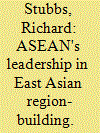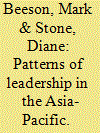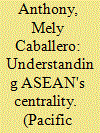|
|
|
Sort Order |
|
|
|
Items / Page
|
|
|
|
|
|
|
| Srl | Item |
| 1 |
ID:
132400


|
|
|
|
|
| Publication |
2014.
|
| Summary/Abstract |
Despite none of its members being a major economic or military power, the Association of Southeast Asian Nations (ASEAN) has played a leading role in building East Asia's regional institutions. In exploring this apparent puzzle, the analysis reviews the literature on state leadership at the regional and international level, asks why the region's major powers ceded leadership on the question of regional institution building to ASEAN, and assesses the consequences for East Asia's regional architecture of ASEAN's leadership role in institution-building. The conclusion is that leadership at the state level entails a state, or a group of states, proposing, executing and getting others to agree on a course of action to deal with a specific problem or challenge. The analysis also underscores the point that, while ASEAN has been the leader in East Asian institution-building, the Association and its members should not automatically be expected to play a leadership role on all issues preoccupying the region.
|
|
|
|
|
|
|
|
|
|
|
|
|
|
|
|
| 2 |
ID:
132401


|
|
|
|
|
| Publication |
2014.
|
| Summary/Abstract |
Indonesia is often regarded as the natural leader of the Association of Southeast Asian Nations (ASEAN) in light of its geographical dimensions, large population, strategic position and natural resources. The country has felt entitled to a position of leadership and has generally been recognized by the other ASEAN members as first among equals. While the de facto leadership of Indonesia has traditionally been accepted as conventional wisdom, little attention has been given to the extent to which Jakarta has actually succeeded in exercising leadership in ASEAN and how its attempt to do so has been perceived by the other Southeast Asian states. The paper explores this question by focusing on Indonesia's ability to provide international public goods in the areas of security and economics, engage in conflict management and promote institution building. It argues that the country has sought to establish a stable and autonomous security environment, to conduct conflict meditation efforts in the Cambodian conflict and the South China Sea disputes, and to develop institutional mechanisms to promote security, democracy and human rights among other issues. Still, Indonesia's leadership in ASEAN has been incomplete due to resistance from some members to its preference for an autonomous regional order and in recent years a democratic form of domestic governance. Its leadership has so far also been limited to the political and security spheres, leaving other sectors, like the economy, to others.
|
|
|
|
|
|
|
|
|
|
|
|
|
|
|
|
| 3 |
ID:
132399


|
|
|
|
|
| Publication |
2014.
|
| Summary/Abstract |
Leadership at the regional level has come under the spotlight not only in the post-Cold War context, but also more recently following the global financial crisis. Yet, leadership by states within region-building and regional associations as leaders vis-à-vis other regions or powers remains relatively new territory for analysis and consideration, even though the Association of Southeast Asian Nations (ASEAN) has attracted both admirers and sceptics. This introductory essay is intended to achieve two principal objectives regarding this symposium addressing Asia-Pacific regional leadership. First, we seek to put the 'Asia-Pacific' in historical context and identify some of the forces that have not only shaped but also hindered its realization. Recognizing China's historical role and contemporary rise is important to understand the parameters within which ASEAN and its member states seek to define particular visions of regional identity and enact collective enterprises. The other key background consideration when thinking about contemporary leadership in the Asia-Pacific is that the United States is seemingly in decline. The Asia-Pacific's two most consequential powers - the United States and China - are pervasive considerations for any regional organization that aims to lead and promote cooperation to solve collective action problems.
|
|
|
|
|
|
|
|
|
|
|
|
|
|
|
|
| 4 |
ID:
132402


|
|
|
|
|
| Publication |
2014.
|
| Summary/Abstract |
There have been a number of articles about ASEAN's centrality in the regional security architecture of Asia. Yet, the notion of centrality remains undefined and under-operationalised. Implicit in the discourses of centrality is the idea of ASEAN's leadership, which in turn raises questions about ASEAN's ability to do so, given its limited capacity. This article defines ASEAN's centrality from the perspective of social network approach and argues that ASEAN's structural position in the density of networks that it has established and those that it has linkages with explains ASEAN's centrality. Despite its lack of material power, ASEAN has been able to claim centrality because of its position as a node in a cluster of networks, and this condition of 'high betweenness' allows ASEAN to exercise influence in regional processes with the tacit acceptance of major powers. However, while centrality may have been achieved, maintaining centrality in a rapidly changing regional environment compels ASEAN to address challenges to its centrality. This would necessarily include its ability to maintain consensus, carry out collective action and achieve its stated goals.
|
|
|
|
|
|
|
|
|
|
|
|
|
|
|
|
|
|
|
|
|